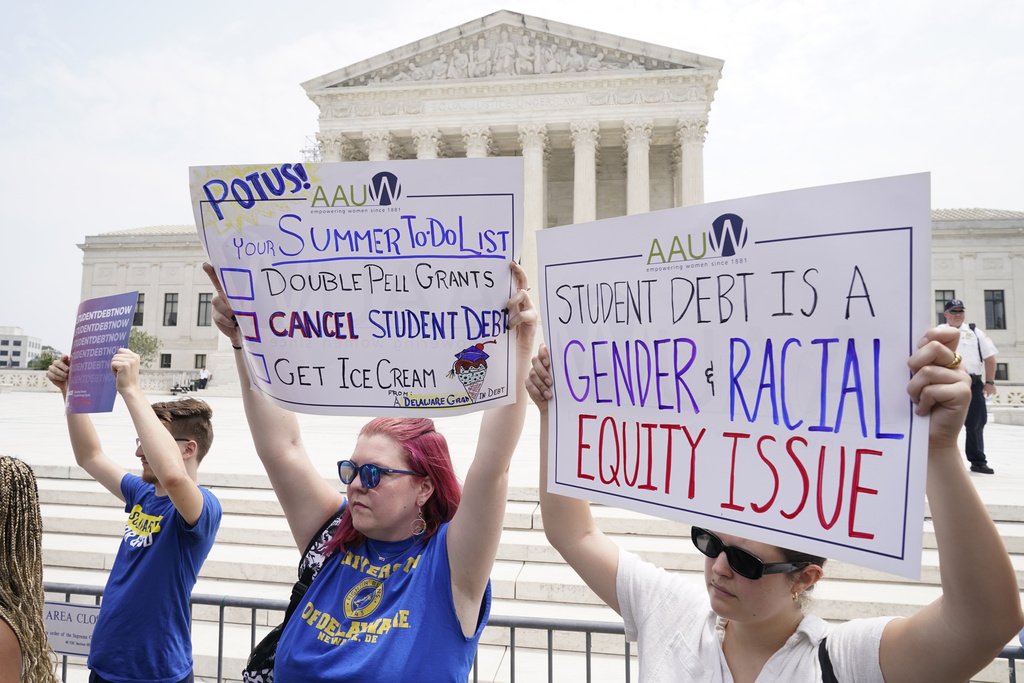Student Borrowers Face Uncertainty with Trump’s Election \ Newslooks \ Washington DC \ Mary Sidiqi \ Evening Edition \ Borrowers like Savannah Britt, who owes $27,000 from her college education, are facing a return to monthly payments following President-elect Donald Trump’s victory. Biden’s ambitious loan forgiveness plans were halted by legal challenges, and Trump’s administration may signal a pivot away from widespread relief. Advocacy groups stress the importance of staying informed as potential changes in student loan policy unfold.
Student Loan Forgiveness Stalled: Borrowers Brace for Uncertain Future: Quick Looks
- Borrowers Affected: Millions, including individuals like Savannah Britt and Sabrina Calazans, could soon resume loan payments.
- Biden’s Plans: Initial mass forgiveness and subsequent efforts faced Supreme Court and federal judicial blocks.
- Trump’s Perspective: Critical of Biden’s debt relief, Trump campaigned on the inefficacy of mass loan cancellation.
- Policy Projections: Analysts predict Trump’s administration may scale back existing forgiveness measures and shift focus.
- Economic Pressure: Rising financial burdens for borrowers compound economic worries beyond inflation.
- Public Opinion: University of Chicago/AP-NORC poll found only 30% of U.S. adults approved Biden’s handling of student debt.
- Historical Efforts: Biden administration secured relief for over 5 million through updated forgiveness programs.
- Future Uncertainty: Trump’s proposed elimination of the Department of Education could change loan management.
Deep Look
Biden’s plan to cancel up to $20,000 in student loans for eligible borrowers was blocked by the Supreme Court, halting widespread relief efforts. A subsequent, narrower proposal was also stalled by a federal judge after challenges from GOP-led states. Additionally, a separate policy intended to reduce loan payments for those in financial hardship has been paused due to similar lawsuits. These legal battles have kept loan forgiveness out of reach for millions, despite Biden’s commitment to easing the student debt crisis.
Trump’s campaign criticized Biden’s forgiveness plans, calling them a “total catastrophe” that unfairly benefited some borrowers at the expense of others. Bob Eitel, a senior counselor to the education secretary during Trump’s first term and now president of the Defense of Freedom Institute for Policy Studies, indicated that Trump’s incoming administration would not pursue blanket loan forgiveness. “The Trump administration may pursue different avenues of loan relief, but it will not be the mass blanket types of forgiveness that the current administration has pursued,” Eitel stated.
The burden of student loans remains a pressing concern for millions of Americans. Persis Yu, managing counsel for the Student Borrower Protection Center, highlighted that for many borrowers, the cost of student loans contributes significantly to financial strain. “That’s a big part of what is making life unaffordable for them,” Yu explained, emphasizing that student debt is intertwined with broader economic pressures like inflation and the cost of living.
Public sentiment regarding Biden’s handling of student loans has been mixed. A spring poll conducted by the University of Chicago Harris School of Public Policy and The Associated Press-NORC Center for Public Affairs Research found that only 30% of adults approved of Biden’s approach to student debt. The poll indicated a wide range of opinions, with 40% disapproving and others remaining neutral or unsure.
For borrowers like Sabrina Calazans, who holds $30,000 in federal loans from Arcadia University, the uncertainty is daunting. Calazans, now the managing director for the Student Debt Crisis Center, shared that her payments, also on pause, could soon restart at over $300 per month. “As a first-generation American, I live at home with my family, I contribute to our household finances, and that payment is a lot for me and so many others like me,” she said. Calazans stressed that confusion surrounding student loan policies affects a wide range of borrowers, not just young graduates. Parents who have taken out loans for their children and older adults returning to school are also navigating significant debt burdens.
Calazans advises borrowers to stay informed as policies continue to evolve. Using resources like the Federal Student Aid loan simulator and following updates on forgiveness qualifications and repayment options are essential steps to staying prepared. The Trump administration’s potential pivot on student loan policies could include changes that reshape the repayment landscape, making it more vital than ever for borrowers to remain engaged and proactive.
The student loan landscape now enters a period of flux. Borrowers, advocates, and policymakers alike are bracing for what comes next as Trump prepares to take office. Whether through legislative changes, executive action, or the restructuring of existing systems, the upcoming years will be critical for millions who are grappling with the weight of student debt.







